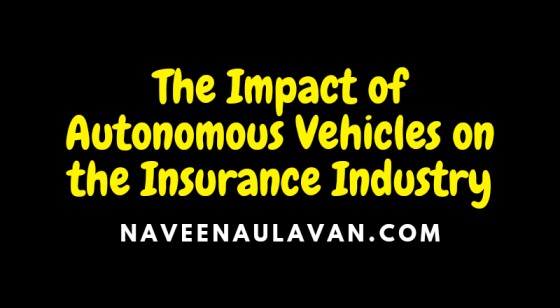Autonomous vehicles (AVs) are transforming the transportation industry, with companies such as Tesla, Waymo, and Uber investing heavily in their development. These vehicles have the potential to improve road safety, reduce congestion, and lower emissions. However, as AVs become more prevalent on the roads, they will have a significant impact on the insurance industry. In this article, we will explore how AVs will affect the insurance industry, including changes to the types of insurance products offered, the risk landscape, and the role of insurers in AVs’ development.
Types of Insurance for Autonomous Vehicles
As AVs become more common on the roads, the types of insurance products offered will need to change to reflect the new risk landscape. Currently, the insurance products for AVs are similar to those for traditional cars, such as liability, collision, and comprehensive coverage. However, as AVs become more advanced, insurance products will need to adapt to reflect the unique risks and challenges associated with autonomous driving.
One possible insurance product for AVs is usage-based insurance (UBI). UBI is a type of auto insurance that charges drivers based on how much they drive, their driving behavior, and the time of day they drive. UBI has been around for a while, but it has been slow to catch on due to privacy concerns and the difficulty of tracking driving behavior. However, with the advent of AVs, UBI could become more common since AVs can be easily tracked and their driving behavior analyzed. UBI could be especially useful for AVs used for ride-sharing since they are likely to be driven more often and for longer periods than privately owned cars.
Another possible insurance product for AVs is cybersecurity insurance. As AVs become more connected and reliant on software, the risk of cyber-attacks increases. Cybersecurity insurance would protect against losses due to cyber-attacks, such as ransomware or hacking of the vehicle’s control systems. This type of insurance is still in its early stages, but as AVs become more prevalent, it will likely become more important.
The Risk Landscape for Autonomous Vehicles
The risk landscape for AVs is different from that of traditional cars. While AVs have the potential to reduce accidents and make roads safer, they also introduce new risks, such as cybersecurity risks and product liability. As a result, insurers will need to evaluate and price these new risks differently.
One of the biggest risks associated with AVs is product liability. In the event of an accident involving an AV, determining fault can be complicated since there are multiple parties involved, including the manufacturer, the software developer, and the owner or operator of the vehicle. As a result, product liability insurance will be crucial for AV manufacturers and software developers. Product liability insurance protects against losses due to defects in the product or design, and it is likely to become more expensive for AV manufacturers due to the increased complexity of these vehicles.
Another risk associated with AVs is cybersecurity. AVs are essentially computers on wheels, and as such, they are vulnerable to cyber-attacks. Cybersecurity risks include hacking of the vehicle’s control systems, stealing of personal data from the vehicle’s sensors and cameras, and ransomware attacks. Insurers will need to evaluate and price these risks differently, and cybersecurity insurance is likely to become more common as AVs become more prevalent.
The Role of Insurers in Autonomous Vehicles’ Development
Insurers have an important role to play in the development of AVs. As AVs become more prevalent on the roads, insurers can help to incentivize the development of safer and more reliable AVs by offering lower insurance premiums to vehicles that meet certain safety standards. Insurers can also work with AV manufacturers and software developers to identify and mitigate potential risks, such as cybersecurity risks and product defects.
Insurers can also play a role in promoting the adoption of AVs. By offering insurance products that are tailored to AVs, insurers can make AV ownership and usage more accessible and affordable. For example, by offering usage-based insurance or cybersecurity insurance, insurers can help to address some of the unique risks associated with AVs and make them more appealing to potential customers.
Insurers can also contribute to the development of AV regulations. As AVs become more common, governments around the world will need to create regulations to ensure their safe and reliable operation. Insurers can provide valuable input into the development of these regulations by sharing data and insights on the risks associated with AVs. By working with regulators, insurers can help to create a regulatory framework that supports the safe and responsible development of AVs.
Conclusion
Autonomous vehicles are transforming the transportation industry, and they will have a significant impact on the insurance industry as well. As AVs become more prevalent on the roads, insurers will need to adapt to the new risk landscape and offer new types of insurance products that are tailored to AVs. Insurers can also play an important role in the development of AVs by incentivizing the development of safer and more reliable vehicles, promoting the adoption of AVs, and contributing to the development of AV regulations. As the development and adoption of AVs continue to accelerate, the insurance industry will need to adapt quickly to keep pace with this rapidly changing landscape.
